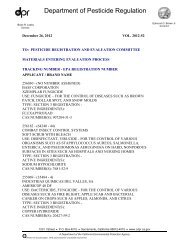Dichlorvos (DDVP) Risk Characterization Document - California ...
Dichlorvos (DDVP) Risk Characterization Document - California ...
Dichlorvos (DDVP) Risk Characterization Document - California ...
You also want an ePaper? Increase the reach of your titles
YUMPU automatically turns print PDFs into web optimized ePapers that Google loves.
VI. TOLERANCE ASSESSMENT<br />
A. BACKGROUND<br />
A tolerance is the maximum amount of pesticide residue that may remain in or on a food, or animal<br />
feed (USEPA, 1991d). The USEPA tolerance program was developed as an enforcement mechanism<br />
to identify illegal residue concentrations resulting from potential non-compliance with the product label<br />
requirements (e.g. improper application rates or methods, inadequate pre-harvest intervals, direct or<br />
indirect application to unapproved commodities). Tolerances are enforced by the FDA, the USDA, and<br />
state enforcement agencies (e.g. Pesticide Enforcement Branch of DPR).<br />
The data requirements established by USEPA for tolerances include: (1) residue chemistry which<br />
includes measured residue levels from field studies, (2) environmental fate studies, (3) toxicology<br />
studies which evaluate the hazards to humans, domestic animals, and non-target organisms, (4)<br />
product performance such as efficacy, and (5) product chemistry which includes physical-chemical<br />
characteristics and analytical method (Code of Federal Regulations, 1992). The field studies must<br />
reflect the proposed use with respect to the rate and mode of application, number and timing of<br />
applications, and formulations proposed (USEPA, 1982).<br />
Currently, the tolerances set by USEPA are at levels necessary for the maximum application rate and<br />
frequency, and not expected to produce deleterious health effects in humans from chronic dietary<br />
exposure (USEPA, 1991d). USEPA uses Reference Doses for non-cancer risks, and negligible levels<br />
(generally defined as a lifetime probability of tumor occurrence at one in a million) for cancer risks as<br />
guides to determine the appropriate levels for dietary exposure.<br />
Assembly Bill 2161 (Bronzan and Jones, 1989) requires the DPR to "conduct an assessment of<br />
dietary risks associated with the consumption of produce and processed food treated with pesticides".<br />
In the situation where "any pesticide use represents a dietary risk that is deleterious to the health of<br />
humans, the DPR shall prohibit or take action to modify that use or modify the tolerance.....". As part<br />
of the tolerance assessment, a theoretical dietary exposure for a specific commodity and specific<br />
population subgroups can be calculated from the product of the tolerance and the daily consumption<br />
rate.<br />
B. ACUTE EXPOSURE<br />
An acute exposure assessment using the residue level equal to the tolerance is conducted for each<br />
individual label-approved commodity. The TAS Exposure-4 software program and the USDA<br />
National Food Consumption Survey (USDA, 1987-1988) are used in this assessment. The acute<br />
tolerance assessment does not routinely address multiple commodities at the tolerance levels since<br />
the probability of consuming multiple commodities at tolerance levels decreases as the number of<br />
commodities included in the assessment increases. A list of all the tolerances is in Appendix A. The<br />
printouts from the TAS program analysis are on file at the Medical Toxicology Branch and are<br />
available on request.<br />
In this document, the tolerances of raw agricultural commodities, milk, eggs, and meats were<br />
evaluated. The tolerance for mushrooms was not evaluated since the use has been deleted from the<br />
labels. Based on the 95th percentile user-day exposures and the acute NOEL of 0.5 mg/kg-day for<br />
cholinergic signs observed in the rats (Lamb 1992; and Lamb 1993a), the MOSs were greater than<br />
800 for all population subgroups for the tolerances of tomatoes, radishes, poultry, eggs, beef, veal,<br />
pork, and sheep. The MOSs were greater than 200 for all population subgroups, with one exception,<br />
for the tolerances of cucumber, lettuce, and milk. The MOS for children (1-6 years) was 160 for the<br />
tolerance of lettuce. The MOSs for all other tolerances were greater than the benchmark level of 100<br />
considered sufficient for the protection of human health.<br />
78
















